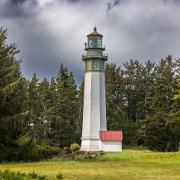
7 2024 Road Trip - Day 35
The Grays Harbor Lighthouse, standing as a beacon on the Washington coast, has a rich history dating back to the late 19th century. Commissioned to improve maritime safety in the treacherous waters of the Pacific Northwest, the lighthouse was completed in 1898. It was designed by renowned lighthouse engineer Carl W. Leick, featuring a distinctive octagonal tower that rises 107 feet, making it the tallest lighthouse in Washington State. Constructed of brick and concrete, its sturdy design has allowed it to withstand the harsh coastal weather for over a century. Initially, the light was powered by a kerosene lamp, which was later upgraded to a first-order Fresnel lens, amplifying its reach to guide ships safely into Grays Harbor.
Throughout the early 20th century, the Grays Harbor Lighthouse played a crucial role in the region's maritime activities, guiding countless vessels through fog and storm. The lighthouse keepers, tasked with maintaining the light and its surrounding facilities, often faced challenging and isolated conditions. Their dedication ensured that the lighthouse operated continuously, preventing numerous shipwrecks and maritime disasters. Automation came in 1960, marking the end of the era of lighthouse keepers, yet the Grays Harbor Lighthouse remains a symbol of the enduring human effort to navigate and tame the perilous seas.
The Grays Harbor Lighthouse, standing as a beacon on the Washington coast, has a rich history dating back to the late 19th century. Commissioned to improve maritime safety in the treacherous waters of the Pacific Northwest, the lighthouse was completed in 1898. It was designed by renowned lighthouse engineer Carl W. Leick, featuring a distinctive octagonal tower that rises 107 feet, making it the tallest lighthouse in Washington State. Constructed of brick and concrete, its sturdy design has allowed it to withstand the harsh coastal weather for over a century. Initially, the light was powered by a kerosene lamp, which was later upgraded to a first-order Fresnel lens, amplifying its reach to guide ships safely into Grays Harbor.
Throughout the early 20th century, the Grays Harbor Lighthouse played a crucial role in the region's maritime activities, guiding countless vessels through fog and storm. The lighthouse keepers, tasked with maintaining the light and its surrounding facilities, often faced challenging and isolated conditions. Their dedication ensured that the lighthouse operated continuously, preventing numerous shipwrecks and maritime disasters. Automation came in 1960, marking the end of the era of lighthouse keepers, yet the Grays Harbor Lighthouse remains a symbol of the enduring human effort to navigate and tame the perilous seas.
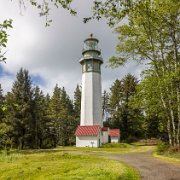
8 2024 Road Trip - Day 35
The Grays Harbor Lighthouse, standing as a beacon on the Washington coast, has a rich history dating back to the late 19th century. Commissioned to improve maritime safety in the treacherous waters of the Pacific Northwest, the lighthouse was completed in 1898. It was designed by renowned lighthouse engineer Carl W. Leick, featuring a distinctive octagonal tower that rises 107 feet, making it the tallest lighthouse in Washington State. Constructed of brick and concrete, its sturdy design has allowed it to withstand the harsh coastal weather for over a century. Initially, the light was powered by a kerosene lamp, which was later upgraded to a first-order Fresnel lens, amplifying its reach to guide ships safely into Grays Harbor.
Throughout the early 20th century, the Grays Harbor Lighthouse played a crucial role in the region's maritime activities, guiding countless vessels through fog and storm. The lighthouse keepers, tasked with maintaining the light and its surrounding facilities, often faced challenging and isolated conditions. Their dedication ensured that the lighthouse operated continuously, preventing numerous shipwrecks and maritime disasters. Automation came in 1960, marking the end of the era of lighthouse keepers, yet the Grays Harbor Lighthouse remains a symbol of the enduring human effort to navigate and tame the perilous seas.
The Grays Harbor Lighthouse, standing as a beacon on the Washington coast, has a rich history dating back to the late 19th century. Commissioned to improve maritime safety in the treacherous waters of the Pacific Northwest, the lighthouse was completed in 1898. It was designed by renowned lighthouse engineer Carl W. Leick, featuring a distinctive octagonal tower that rises 107 feet, making it the tallest lighthouse in Washington State. Constructed of brick and concrete, its sturdy design has allowed it to withstand the harsh coastal weather for over a century. Initially, the light was powered by a kerosene lamp, which was later upgraded to a first-order Fresnel lens, amplifying its reach to guide ships safely into Grays Harbor.
Throughout the early 20th century, the Grays Harbor Lighthouse played a crucial role in the region's maritime activities, guiding countless vessels through fog and storm. The lighthouse keepers, tasked with maintaining the light and its surrounding facilities, often faced challenging and isolated conditions. Their dedication ensured that the lighthouse operated continuously, preventing numerous shipwrecks and maritime disasters. Automation came in 1960, marking the end of the era of lighthouse keepers, yet the Grays Harbor Lighthouse remains a symbol of the enduring human effort to navigate and tame the perilous seas.
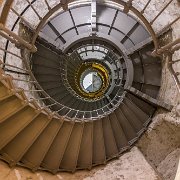
9 2024 Road Trip - Day 35
The Grays Harbor Lighthouse, standing as a beacon on the Washington coast, has a rich history dating back to the late 19th century. Commissioned to improve maritime safety in the treacherous waters of the Pacific Northwest, the lighthouse was completed in 1898. It was designed by renowned lighthouse engineer Carl W. Leick, featuring a distinctive octagonal tower that rises 107 feet, making it the tallest lighthouse in Washington State. Constructed of brick and concrete, its sturdy design has allowed it to withstand the harsh coastal weather for over a century. Initially, the light was powered by a kerosene lamp, which was later upgraded to a first-order Fresnel lens, amplifying its reach to guide ships safely into Grays Harbor.
Throughout the early 20th century, the Grays Harbor Lighthouse played a crucial role in the region's maritime activities, guiding countless vessels through fog and storm. The lighthouse keepers, tasked with maintaining the light and its surrounding facilities, often faced challenging and isolated conditions. Their dedication ensured that the lighthouse operated continuously, preventing numerous shipwrecks and maritime disasters. Automation came in 1960, marking the end of the era of lighthouse keepers, yet the Grays Harbor Lighthouse remains a symbol of the enduring human effort to navigate and tame the perilous seas.
The Grays Harbor Lighthouse, standing as a beacon on the Washington coast, has a rich history dating back to the late 19th century. Commissioned to improve maritime safety in the treacherous waters of the Pacific Northwest, the lighthouse was completed in 1898. It was designed by renowned lighthouse engineer Carl W. Leick, featuring a distinctive octagonal tower that rises 107 feet, making it the tallest lighthouse in Washington State. Constructed of brick and concrete, its sturdy design has allowed it to withstand the harsh coastal weather for over a century. Initially, the light was powered by a kerosene lamp, which was later upgraded to a first-order Fresnel lens, amplifying its reach to guide ships safely into Grays Harbor.
Throughout the early 20th century, the Grays Harbor Lighthouse played a crucial role in the region's maritime activities, guiding countless vessels through fog and storm. The lighthouse keepers, tasked with maintaining the light and its surrounding facilities, often faced challenging and isolated conditions. Their dedication ensured that the lighthouse operated continuously, preventing numerous shipwrecks and maritime disasters. Automation came in 1960, marking the end of the era of lighthouse keepers, yet the Grays Harbor Lighthouse remains a symbol of the enduring human effort to navigate and tame the perilous seas.
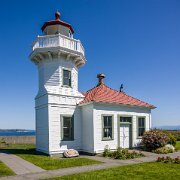
10 2024 Road Trip - Day 38
Mukitteo Lighthouse,
Mukitteo, Washington
The Mukilteo Lighthouse, a prominent historical beacon located in Mukilteo, Washington, was constructed in 1906. It was built during an era of rapid maritime development in the Pacific Northwest, serving as a crucial navigational aid for ships traversing the treacherous waters of Puget Sound. The United States Lighthouse Board, recognizing the need for such a facility, initiated its construction, which was completed swiftly due to the strategic importance of the location. The design of the lighthouse follows a standard pattern typical of the early 20th century, featuring a square wooden tower attached to a keeper's quarters, reflecting the architectural preferences of the period.
The lighthouse's construction involved the use of durable materials such as wood and brick to withstand the harsh coastal weather conditions. The structure stands 38 feet tall, with its original fourth-order Fresnel lens, which was a state-of-the-art optical device at the time, enabling it to project light up to 12 nautical miles. The Mukilteo Lighthouse was fully automated in 1979, yet the building itself has been meticulously preserved, retaining its historical charm and significance. This lighthouse not only marks a navigational point but also serves as a symbol of the maritime heritage of Mukilteo, embodying over a century of history and coastal development.
Mukitteo Lighthouse,
Mukitteo, Washington
The Mukilteo Lighthouse, a prominent historical beacon located in Mukilteo, Washington, was constructed in 1906. It was built during an era of rapid maritime development in the Pacific Northwest, serving as a crucial navigational aid for ships traversing the treacherous waters of Puget Sound. The United States Lighthouse Board, recognizing the need for such a facility, initiated its construction, which was completed swiftly due to the strategic importance of the location. The design of the lighthouse follows a standard pattern typical of the early 20th century, featuring a square wooden tower attached to a keeper's quarters, reflecting the architectural preferences of the period.
The lighthouse's construction involved the use of durable materials such as wood and brick to withstand the harsh coastal weather conditions. The structure stands 38 feet tall, with its original fourth-order Fresnel lens, which was a state-of-the-art optical device at the time, enabling it to project light up to 12 nautical miles. The Mukilteo Lighthouse was fully automated in 1979, yet the building itself has been meticulously preserved, retaining its historical charm and significance. This lighthouse not only marks a navigational point but also serves as a symbol of the maritime heritage of Mukilteo, embodying over a century of history and coastal development.
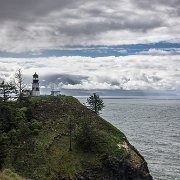
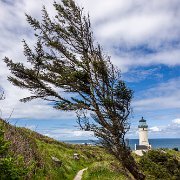
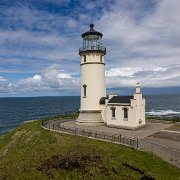
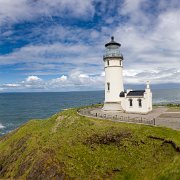
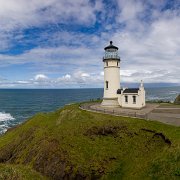
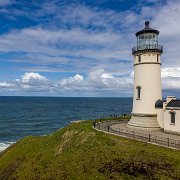
Washington